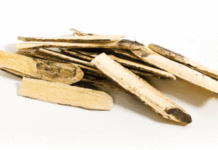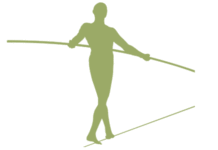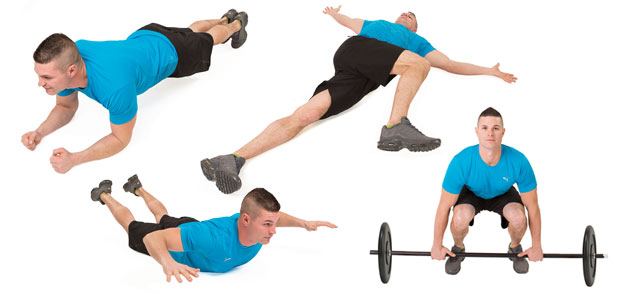
With commitment, education, and targeted exercises such as these, you\’ll be able to strengthen your back in no time.
If you’ve never had a neck, spine, or hip injury, but suffer from back pain or frequently throw your back out, it can almost always be attributed to two things: weakness and tightness. Regardless of your age or activity level, your back can always be stronger, and the pain can usually be managed.
Types of back pain
Back health is not just a product of your back. Rather, it is a product of your entire back side, known as your posterior chain. Believe it or not, tight calf muscles can elicit back pain. There are two mechanisms of back pain: acute and chronic.
Acute
Acute back pain is the result of a direct trauma to the spine or back muscles that often requires rest and a comprehensive rehabilitation program. You should see a health care practitioner, physiotherapist, or chiropractor if you suffer from this kind of injury.
Chronic
Chronic back pain can often be fixed by you, by knowing which muscles to strengthen and which muscles to stretch. With the proper knowledge and persistence, you can change your mobility from Frankenstein to Franken-fine.
Treatments for back injuries
When treating a back injury, a multidisciplinary therapeutic approach is most effective. This comprises various combinations of exercise, education, and behavioural therapy. The goal of these therapies is to strengthen and stretch supporting muscles, teach which movement patterns are safe and which put your back at risk (for example, you should lift a heavy object off the ground using your legs and hips instead of bending at the back), and retrain the mind to change certain habits that can be damaging.
In addition to these therapies, herbs such as devil’s claw and white willow bark have been shown to be effective in chronic back pain management. Cayenne may also be helpful when applied topically as a plaster. Consult your local health food store for more information about these remedies.
Weak core strength—referring to the inner core muscle, the transversus abdominis (TVA)—is commonly identified as a contributing factor to chronic lower back pain. Not only training the TVA but also teaching proper core activation and engagement are critical to improving quality of life in sufferers and preventing future occurrence of back injury.
Exercises for back health
For those suffering with back pain due to a spinal cord injury or acute injury, there are many movements that can aggravate and exacerbate the condition. Due to the specific nature of these injuries, exercises are limited to specialist prescription.
For those with chronic back pain brought on by years of poor mechanics and questionable posture, limitations stem only from flexibility and pain tolerance. (As a general rule, discomfort is okay; pain is bad.)
When done properly and with appropriate resistance, almost any exercise will benefit your body, with one exception: the sit-up. Even when performed “properly,” this one-time staple of every fitness routine has a proven link with lower back pain. Sit-ups aside, try these three exercises and two stretches to strengthen your back and straighten your posture.
Plank with an Alternating L-Tap

(3 sets of 30 seconds, or until your lower back goes from rounded to arched)
Muscles worked: transversus abdominis, posterior deltoids, quadriceps
- Start in plank position, maintaining an equal balance between your forearms and toes.
- Keep your elbows directly underneath your shoulders, your feet together, and your legs straight.
- Once you are locked in this position, bring your right knee forward as far as you can, tapping your toe to the ground underneath you.
- Return your right foot to starting position.
- With a straight leg, swing your right leg as far up and away from your body as possible and tap the ground.
- Return your right foot to starting position, and then perform the same exercise on the left side. This is one repetition.
Perfect your plank: Throughout the exercise, you should feel like you are trying to push yourself away from the floor (with your elbows). Actively push your hips toward the ground while keeping your hip height above your shoulder height, effectively rounding your lower back.
Barbell Deadlift (3 sets of 12 repetitions)
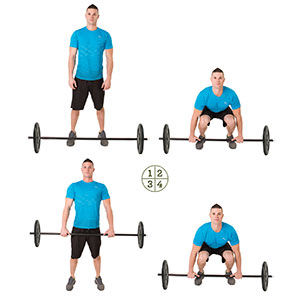
Muscles worked: hamstrings, glutes, lower back, transversus abdominis
- Stand with your feet shoulder-width apart and the barbell overtop your toes.
- Grip the bar with your palms facing you and your hands slightly wider than shoulder width.
- Keep your back flat (that is, there should be no arching or rounding of the lower back), your arms and shoulders relaxed, and your weight in your heels.
- Maintaining a slight bend at the knees (if you are less flexible, you may need a deeper bend), exhale and push your hips forward as you stand up so that your body is as straight and tall as possible.
- Inhale as you deliberately lower the weight to the floor, keeping the same form that you used to lift.
Superman Low Back Extension with a Phantom Pulldown (3 sets of 15 repetitions)
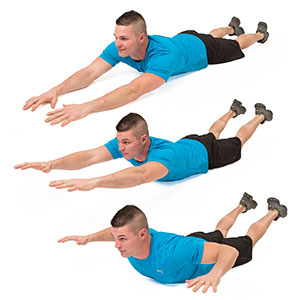
Muscles worked: glutes, lower back, latissimus dorsi, posterior deltoids
- Lie on your stomach with your arms outstretched in front of you and your legs extended behind you, with toes pointed away.
- As you exhale, lift your arms, chest, and legs off the ground as high as you can by arching your back and squeezing your glutes.
- At the peak of your lift, bring your elbows out and down to your sides, squeezing your shoulder blades together.
- Extend your arms back out to the front and then lower.
Lying Crossover Stretch (3 sets of 6 repetitions)
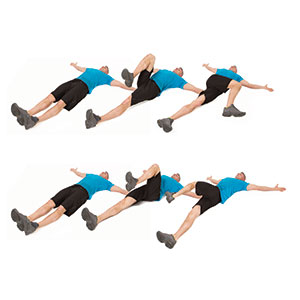
Muscles worked: erector spinae, gluteus medius, pectoralis minor
- Lie on your back with your legs together and extend your arms straight out to the sides, palms up, your body making a “T” shape.
- Inhale as you bend your right leg slightly, bringing your knee overtop your right hip.
- Exhale and let your right leg fall across your body, allowing your hips to roll to the left.
- When your leg can fall no further, complete one deep inhale and one full exhale.
- Inhale and roll your hips back to the floor, bringing your knee back overtop your right hip.
- Bring your right leg back to starting position, and then perform the same exercise on the left side. This is one repetition.
Child’s Pose into Cat Pose (3 sets of 12 repetitions)
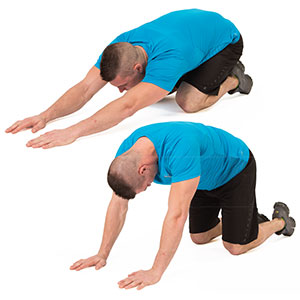
Muscles worked: erector spinae, quadratus lumborum, latissimus dorsi, trapezius
- Begin on your hands and knees with your toes pointed behind you, the tops of your feet lying flat on the ground.
- With your hands together and outstretched as far as possible on the ground in front of you, inhale deeply and sit back toward your heels, actively pressing your head and chest toward the ground.
- Exhale fully in this position.
- Inhale deeply as you slowly shift your body forward so that your shoulders end up over your hands.
- As you shift your body, tuck your chin toward your chest and round your lower back.
- Exhale fully in this position, and then return to starting position. This is one repetition.


































